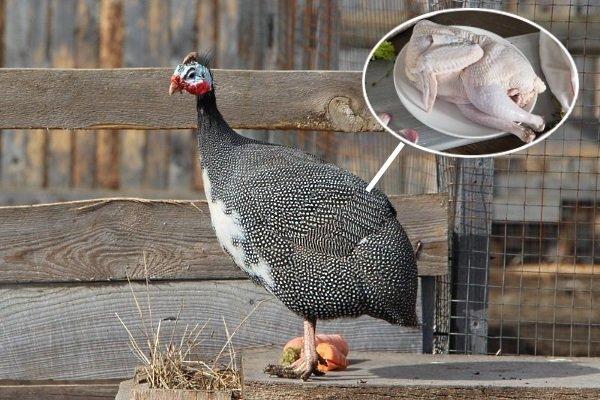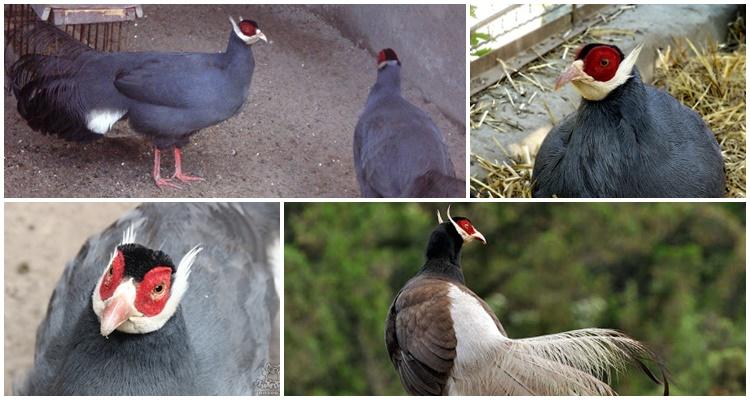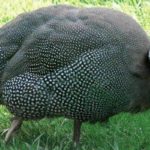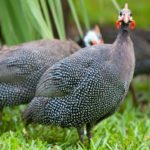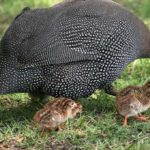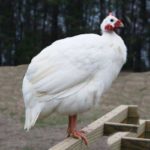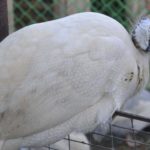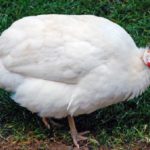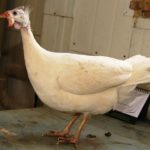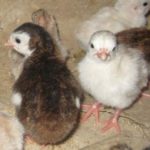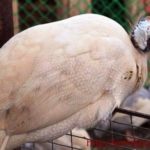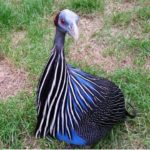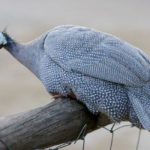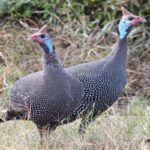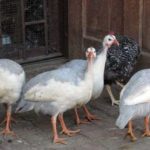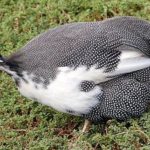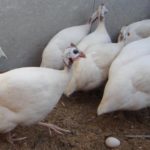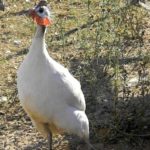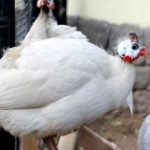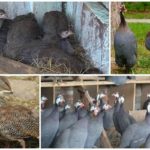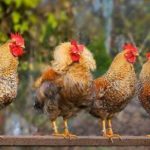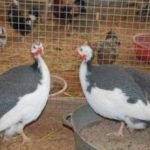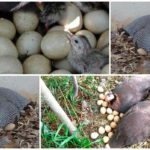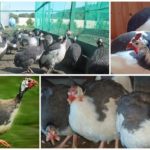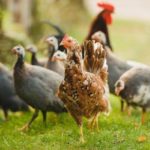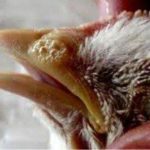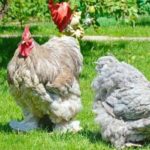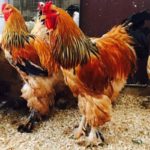Guinea fowl differ in body composition and appearance from other types of poultry. Despite the fact that it was domesticated relatively recently, breeds have already been bred for industrial and home breeding. Let's look at what adult and young guinea fowl look like, their productive characteristics, as well as a description, advantages and disadvantages of several breeds of poultry.
What does a guinea fowl look like?
Birds are different from members of the chicken family, so it can be easy to tell them apart.Differences relate to physique, plumage, development and behavior.
Adult bird
The common guinea fowl can be recognized by its characteristic oval body, located horizontally, and dark gray plumage with small white specks. Males and females are colored the same. The bird has an unfeathered neck and head. The small head has a hard crest and wattles, and a vocal sac under the throat. The guinea fowl's legs are high, thin, without spurs.
Guinea fowl have thin skin and the meat is darker than chicken. After cooking, the meat becomes lighter in color. The weight of birds at the age of 1 year is 1.8 kg for males and 1.5 kg for females. You can distinguish a male from a female by the head: they have horny processes of different shapes and fleshy beards. A characteristic feature of this species of birds is that females lay eggs in a common rather than individual nest.
Young animals
The body of small guinea fowl is covered with yellow down, with brown spots and stripes on the back and head. By the age of one month, the chicks are covered with the plumage characteristic of adult birds. They grow up to 5 months at the same rate as egg-laying hens. Then the growth of males stops, while the growth of females continues. By the beginning of the first oviposition, they weigh more than males, after which, by the time of molting, the size and weight of males begins to predominate.
Guinea fowl chicks are mobile and active, from the 3-5th day of life they gather in flocks and move in groups, rather than alone.
Productivity
Females begin to lay eggs at 8-8.5 months. Over a 5-6 month period, the egg production of each is 80-90 eggs, 45 g each.The size and weight of eggs varies depending on the age of the hen and the time of year. The largest eggs are laid by 2-year-old guinea fowl, as well as all birds in the summer; the smallest eggs are laid by young laying hens.
Other characteristics: fertilization rate is at the level of 86%, 52-55% of chicks are hatched. Females of many breeds do not incubate chicks; in most cases, incubators are used for hatching. Eggs contain more dry matter and vitamins, they taste better than chicken eggs and are not allergenic. They are stored for up to six months.
Young birds almost never die, just like adult birds; 95-99% of the population survive. At 2 months, guinea fowl weigh 0.8 kg; per 1 kg of weight gain, 3.2-3.4 kg of feed is consumed. Birds are slaughtered no earlier than 5 months. After this age, growth does not stop, so in order to obtain larger carcasses and meat of better quality, birds can be left for further feeding or selection for breeding stock.
Popular breeds of guinea fowl for home breeding
In a home poultry house, you can breed and raise guinea fowl of various breeds, both meat and egg production. They have different characteristics.
Speckled gray guinea fowl (French)
This is the most common breed; most birds in private farms belong to it. Speckled-gray breed of meat-egg direction. The birds reach a weight of 1.7 kg, the number of eggs is 90 pcs. The bird's body is harmoniously developed, oblong, oval, gray plumage with white specks.
Due to its undemanding nature, the speckled gray breed can be grown even by a beginner.
White Siberian breed of guinea fowl
The plumage color is pure white, the skin and legs are light. The main advantage of the breed over other breeds of domestic guinea fowl is its high egg production; each female lays almost a quarter more eggs than females of other varieties. Their average weight is 50 g.
Due to its cold resistance, this breed can be kept in regions with cold climates. It is often chosen by Siberian poultry farmers.
Suede guinea fowl
Obtained randomly as a result of mutations that occurred with gray-speckled guinea fowl. The plumage is light gray with white specks. The legs, skin and beak are darker than those of the Siberian or White-breasted breed. Males after 2 months of life are lighter in color than females; by this feature they can be distinguished by sex.
A peculiarity of the breed is that laying hens can lay eggs with yellow and brownish shells.
Blue guinea fowl
The breed is named because of its blue-gray plumage with white spots.
In terms of prevalence and productive characteristics, blue guinea fowl are in second place after gray-speckled ones.
Zagorsk white-breasted guinea fowl
The breed was bred in Russia from representatives of the gray-mottled variety. Zagorsk guinea fowl are larger in size and weight. The plumage is heterogeneous: the back, wings, and belly are light gray with a bluish tint and white specks. The inside of the neck and chest are white. The skin tone is darker on colored areas, lighter where the feathers are white.
The Zagorsk breed is considered promising; many poultry farmers choose it for cultivation on private farms.
White Volga guinea fowl
The ancestors of the breed are the white Siberian variety. Birds with white plumage and high productivity were used for breeding. The color of the white Volga breed is cream or white, the presence of dark feathers is allowed.
The Volga White breed is a suitable choice for experienced poultry farmers and for beginners. Birds are undemanding and productive.
When choosing a breed, you need to decide what to raise guinea fowl for - for meat or eggs. You also need to pay attention not only to size and early maturity, but also to the ability to get used to climatic conditions. Households widely use the peculiarity of this type of bird - they willingly eat insects, bugs, larvae, among which there are often garden pests. It is known what guinea fowl eat with pleasure Colorado potato beetles without disturbing the plants. This skill can be used to destroy pests without resorting to treating plants with chemicals.

